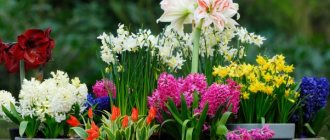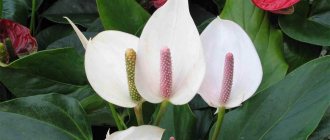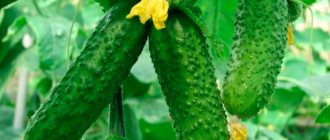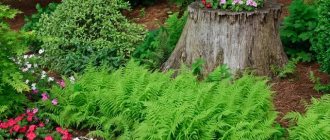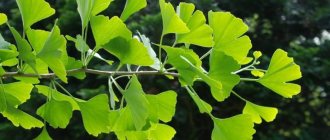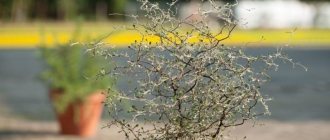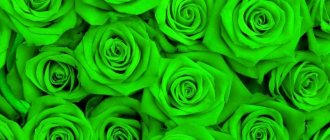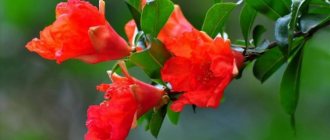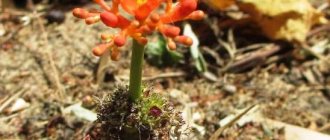The color red symbolizes energy, beauty and love. Therefore, since ancient times, flowers in fiery shades have always been woven into wreaths and planted in flower beds. Times have changed, but this color is still popular in garden design. It is actively used to complement flower beds, make bright accents on the site, and highlight landscape areas. We suggest studying the best red perennials, which stand out for their originality, can harmoniously complement the territory, and add bright accents to the area.
Low growing perennials with red flowers
Low-growing garden crops look great in borders, complementing paths or alleys. These flowers will be a creative option to complement the rest and relaxation area. Let's consider the most interesting options for low-growing crops that will harmoniously fit into any flower bed.
Spring Primrose
These flowers greet us with the first warmth. They truly symbolize spring and provide lush blooms. The bushes are distinguished by wrinkled, wavy leaves covered with hairs. Often primrose is also called “keys”. Traditionally, primrose blooms with yellow buds, but there are many varieties with red petals. The most popular is the Chinese primrose, which has red-brown peduncles. The crops prefer light types of soil and can be propagated by different methods - seed, cuttings, and dividing the bush.
For comfortable growth of bushes, you need to make a distance of 15 centimeters between them. The height of such beauties reaches up to 10-30 cm. Primrose will bloom within a month, starting from April and ending in May.
You might be interested
Decorative liana Ipomoea: cultivation and use in garden design
Red perennials: the best plants to grow in the garden
List of the best blue flowers and plants with blue foliage
Blood Red Cinquefoil
A beautiful perennial with red flowers is blood red cinquefoil. Its height is up to 0.6 meters. The culture is distinguished by straight, branched stems. The leaves are usually trifoliate in shape and have a dull green color on top. This culture is valued due to its flowers of incredible beauty. Their color is usually a brilliant red hue, up to 5 cm in diameter, they form paniculate or corymbose buds. Flowering is long - up to 50 days.
There are a large number of hybrids - among them "Gibson Scarlet", which is distinguished by scarlet-red petals with a slight shiny tint. You can see abundant flowers during June-July.
Border Chrysanthemums
Excellent red perennial flowers are border varieties of chrysanthemums. In gardening, such varieties are also called “Korean” or “Chinese”. These crops are distinguished by the fact that they are resistant to cold conditions and will delight you with long-lasting flowering. Border varieties are considered crumb flowers, which do not reach more than 0.3 meters in height, and independently form the ideal outline of a bush in the form of a ball. “Talisman” is considered the best varieties. These flowers have a bright color in raspberry-beet tones. The “Evening Lights” variety also looks very attractive. With their dazzling flashes of scarlet petals, they will easily complement any area and create incredible holiday euphoria.
Perennial carnation grass
This wild crop is a close relative of the familiar garden carnation. It prefers areas with sandy, permeable soil, as it is very unpretentious in terms of watering and the availability of nutrients. In order to successfully grow and feel good, it does not need any special care at all.
One plant lives from 4 to 7 years, and it does not need replanting. This wild plant grows up to 20 cm in length, forming dense dense clumps. Only one wild variety has a rich red color, but it is most noticeable in green grass. However, carnation grass is capable of growing not only in natural conditions: it can easily adapt to forests, gardens, vegetable gardens, and mountainous areas.
Gardeners love this unpretentious flower for its long flowering with the formation of numerous red red buds. The decorative period lasts about one and a half months, after which the seeds begin to ripen. Reproduction of red carnation grass occurs by self-sowing, so it successfully invades neighboring territories.
Tall perennials with red flowers
If we have figured out the formation of borders, now we should think about how large areas on the site and mixborders will be decorated. The ideal solution in this case would be to use tall representatives with fiery petals. Let's look at the brightest red perennials.
Heleniums or red chamomile perennials
Helenums are tall red perennials that belong to the Asteraceae family. The homeland of such cultures is considered to be the territory of Eastern America. The height of specimens can reach up to 1.6 meters. The stem can be smooth, branched or straight. The leaves are usually lanceolate in shape and do not develop chaotically, but in order of priority.
Helenium usually forms a hemisphere, enveloped in yellow pollen. The central part is framed by circular petals. Visually, they resemble chamomile, hence the second name for heleniums.
Stem height up to 0.9 meters. Flowering can be observed within 5-6 weeks. These perennials will delight you with their fiery flowers from late summer to early autumn. When flowering ends, cylindrical seeds will form on the plant. In order for the bushes to develop beautifully and fully, they need to be watered abundantly and the soil well fertilized.
Exquisite Adonis or Adonis
Adonis is a red perennial that can also be grown as an annual. The plant is actively used in landscape design and has a wide range of healing properties. Therefore, the culture is listed in the International Red Book.
Adonis forms exquisite bushes that are distinguished by their lush appearance. The petals are fiery red in color, visually similar to chamomile. This flower is up to 3 cm in diameter. The total number of species is up to 32. Flowering lasts throughout the whole summer. To grow adonis, it is recommended to choose illuminated areas; the soil can be any kind. If the weather is excessively hot, additional watering of the bushes will be required.
Refined red garden perennial - Poppy
Poppy is a plant that has been familiar to many since childhood. But now, in addition to the usual variety, there are also decorative ones, with terry leaves. The height of the crops is up to 1.2 meters. To make poppies bloom continuously, you need to sow them every 10 days.
These red perennials have narrow leaves with small teeth along the edges. The flowers are created from 4 petals with two sepals. A tap root that goes deep into the ground. For growing poppies, it is better to choose areas with good lighting. Caring for the crop is not burdensome, the main thing is that it does not grow in areas with stagnant moisture or close groundwater.
Original Astilbe
Another red perennial is astilbe. These are herbaceous crops that belong to the Saxifraga family. There are more than 40 varieties of the plant, as well as about 400 cultivars. Astilbe height is up to 2 meters. The flowers form very sophisticated and attractive panicle-shaped inflorescences. Their length is up to 0.6 meters. The color varies, but the red buds deserve special attention. The Japanese astilib Montgomery is distinguished by such beauty. The height of the bushes is up to 0.7 meters, the leaves are usually reddish-brown in color. This beauty begins to bloom in the second half of July, this period lasts for 2 weeks.
When planting astilbes, remember that they do not need a lot of light rays; the ideal solution would be to plant them in light shade. This guarantees long-lasting and abundant flowering.
Lychnis chalcedony
For those looking for interesting and unusual perennials that bloom with red flowers, the sophisticated Lychnises have been bred. These crops belong to the Carnation family and are widespread throughout the Northern Hemisphere. These are rhizomatous plants, distinguished by the presence of an erect stem, its height is up to 1 meter. The leaves are oblong and create a rosette. Such crops bloom from the beginning of summer; the flowers have a thyroid shape. The corolla has a diameter of up to 2 centimeters.
Red perennials will delight you with their flowering for a month. The most popular variety with red petals is Lychnis chalcedony. Its height is up to 1 meter. Representatives have leaves of an erect type, with weak branching.
Design and decor
Decorations should be chosen based on the theme of the wedding. Both an ordinary red ribbon made of satin or lace, casually intercepting the stems, and an abundance of various details - pendants, brooches, beads - are acceptable.
Leg:
- completely covered with cloth or paper;
- they create a fluffy skirt for her from weightless tulle;
- decorated with rhinestones, sparkles, buttons.
The flowers themselves are diluted with feathers, sprigs of berries, and in the fall - with golden leaves and dried flowers.
Idea! Fluffy clouds of cotton will be an excellent white accent - this solution is most popular at winter weddings.
If the petals allow, then decor glued to the buds themselves is acceptable - rhinestones, crystals, butterflies or silk birds.
Red perennials blooming all summer
If you really want, you can find those perennials that will delight you with abundant and long flowering throughout the summer. The most popular flower that can provide this effect is begonia. This culture does not need any special introduction, because it is known and appreciated due to its bright and lush flowering.
The most popular variety is Regal Minuet. The color plates are usually pearl-cherry shades, with a brownish-red spider visible in the center. The edges have a dark red border.
Another representative that will delight you with flowering from June to September is red valerian or centranthus. The bush can reach up to 0.6 meters in diameter. The most popular variety is Coccineus.
To grow valerian on your site, give preference to warm, sunny places that will not be exposed to draft winds. The ideal solution for growing would be planting in rock gardens and rocky gardens. Valerian is propagated by seed through seedlings or by dividing the bush.
Photo
One of the most beautiful and vibrant accessories can be considered the classic bridal bouquet, the red and white color of which is associated only with the most sincere and bright feelings between future spouses. This contrasting attribute will create accents in wedding photos and will not go unnoticed by guests.
Perennials with red foliage
The original red perennials are those that do not have fiery-colored flowers, but leaves. They are able to complement any flower bed, making it more rich and presentable. The most popular are:
Blood red Heuchera
The leaves of this garden crop are distinguished by reddish-green shades.
The plant is ideal for combination with various decorative plantings in green tones.
Extravagant Coleus
This culture looks great in garden beds, various flower beds, and containers.
A very decorative Coleus Blume, which has large-toothed burgundy leaves. Crimson Ruffles also looks beautiful with raspberry-burgundy leaves.
Amaranth
These plants are an ideal solution for planting next to ornamental cabbage.
They prefer light, fertile soils and perfectly complement various types of garden plots.
Red perennials are flowers that will add a pop of color to any area. If you choose undemanding but presentable plants, you will be able to form unrealistic compositions that will make any area extraordinary and sophisticated.
What kind of brides is it suitable for?
Such a classic combination will look great in the hands of any bride. Blondes and very young girls are better off choosing the dominance of white and individual red accents. For older women and hot brunettes, on the contrary, shades of red, only slightly diluted with white, are perfect.
In any case, the composition speaks of tenderness, but at the same time the strength of character of the bride, innocence mixed with ardent love.
A red and white composition will highlight a snow-white dress, but to make the look as complete as possible, it is advisable to add another tone-on-tone accessory with red buds. Shoes, clutch, lipstick, nail polish - the slightest detail will immediately make the bouquet sparkle in your hands with new colors.
It is recommended to choose white buds either tone on tone or slightly darker than the wedding dress so that the fabric does not appear gray.
Swimsuit
This plant from the Buttercup family has long been known in Russia under the name “zharok” or “light”. Apparently, the droplets of heat resembled the red flowers found in meadows and fields. The flower remains equally spectacular in the natural conditions of the Polar Urals, in Mongolia or in the Caucasus mountains.
In nature, the best for the crop are rocky areas of uplands, so the plant is extremely unpretentious either in terms of watering or soil composition. The bush, up to 80 cm high, ends in bright, varnished petals of red or bright orange. Flowering continues from May to June. The inflorescence seems quite weighty, but the red flower heads always remain raised straight up to the sky. Because of this feature, many insects hide from bad weather inside the cup of the swimsuit.
This field crop can grow in clusters, but there are also single specimens that add bright colors to the rich greenery of the field. They look no less advantageous in garden design.
Field tulip
A flower from the Liliaceae family, which is familiar to everyone since childhood. The wild form of the tulip is slightly smaller than its varietal relatives, but no less beautiful. A single bud rises on a dense stem that appears in early spring. Under it, near the ground, there is a leaf rosette, consisting of one to four narrow leaves of a bluish tint. The number of leaves depends on the age of the bulb: a young one is capable of growing only one leaf, while an adult and massive one gives rise to three or four.
Inside the cup of red petals there are black stamens, from which pollen falls abundantly. Propagated by bulbs that grow after flowering. Leaves and all ground organs disappear in the first half of summer. The only thing that can become an obstacle to reproduction and growth is the abundance of moisture in the ground and large puddles that do not dry out for a long time.
The tulip is recognized throughout the world as a symbol of spring. Scientists are amazed by the shape of the inflorescence: this field representative of the fauna is an example of ideal natural three-ray symmetry: six petals (three internal and three external) and stamens are subordinate to it. The ovary, which appears after flowering, is also formed by symmetrical cotyledons.
Few people know that wild tulip bulbs can be used for food as a substitute for regular onions. They have approximately the same flavor tones as the bitter root vegetable. People often used this property during World War II.
Field poppy
An annual plant that grows in nature up to 30-80 cm. Red heads, appearing in spring and the first half of summer, decorate fields and meadows. The leaves of this flower are strongly dissected, gray-green, and may be covered with bristles. The milky sap that emerges after tissue damage can cause burns on the skin, so care should be taken when collecting poppies into a bouquet.
After ripening, a box with a large number of small seeds is formed in place of the former buds, which are sown by self-sowing. People liked the red petals so much that they began to grow this species as a cultivated plant back in the days of Ancient Egypt. Now in the south it is a weed that can worsen the yields of cereals and fodder crops.
The milky juice contained in the unripe seed capsule of the poppy is called “opium”. In an effort to collect as much of this substance as possible, at the end of the last century, many field thickets were destroyed, which were restored with difficulty over the decades. A similar property was used before, but at low concentrations they achieved a harmless hypnotic effect.
Burnet plant
The name of this flower does not come from the red inflorescences, as many believe, but from its hemostatic properties, which are widely used in the pharmaceutical industry. This herbaceous field plant grows up to 90 cm tall. In nature, it grows not only in field conditions, but also on the edges of forests, in swampy areas, on sharp cliffs, etc.
A thick horizontal rhizome stretches underground, which produces many offspring. The small petals can be red, but sometimes reach black-purple. The crop is an excellent honey plant, so swarms of insects are constantly circling over the inflorescences. If you plant burnet in your hell, then in this way you can attract many butterflies throughout the summer.
In addition to its invaluable value in medicine, burnet has found application as an excellent forage crop, which is sometimes grown on an industrial scale due to its unpretentiousness and excellent adaptation to any conditions.
Aquilegia
Former generations of gardeners knew this field plant under the names “orlik” or “columbine”. Most varieties growing in the field are blue or blue in color, but there are also red ones that are very visible from afar. The development cycle of this flower is two-year: in the first year, the shoots and root system develop, and in the second year, a peduncle appears, buds form and flowering occurs. In autumn, the rosette dies off.
In nature, aquilegia can be brick or crimson in color; it forms interesting medium-sized inflorescences, which contain nectar inside. After the small seeds ripen in the fall, they dissipate on their own, and the wind can carry them over long distances. Germination persists for one year.
